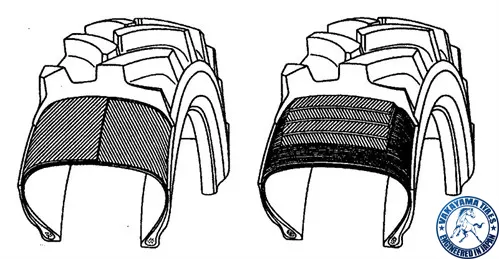Understanding the difference between radial ply and cross ply tyres, and their relative strengths and weaknesses, is important when it comes to deciding between the two
Construction
The significant tyre construction difference between the two tyre ply types is the way that the ply cords are arranged. In cross ply tyre construction, the cords are arranged at a 45-degree angle to the centre line of the wheel and crisscrossed. In a radial ply tyre, the cords are arranged at a 90-degree angle to the centre line of the wheel and overlap.
Cross ply tyres have stronger and less flexible sidewalls as a result of this construction difference, which is advantageous in protecting the inner tube that is essential in cross ply construction. As radial tyre construction does not require an inner tube, the flexibility of the sidewall is advantageous in terms of absorbing vibrations and generating less heat.

Safety
It can be incredibly dangerous if we run tyres which have lost a significant amount of their tread. The rigid nature of cross ply tyres means that heat dissipates less quickly and the tyre will degrade more faster than a radial tyre, increasing the likelihood of an accident due to loss of traction. Cross ply tyres also have a lower speed rating than radial tyres.
Fuel efficiency
A report from the late 1970s by the U.S. Environmental Protection Agency found that on average “radial tyres improved vehicle fuel economy by 5%”. Though it also noted that “for a typical vehicle owner travelling about 10,000 miles or more per year on tyres underinflated by 3 to 4 PSI, the annual fuel savings that would result if this underinflation was corrected is over 45 litres per year”. Thus, when driving on radial tyres, we can be sure we are using the more fuel-efficient tyre type of the two, however, if we don’t keep our tyres properly inflated, we will lose a lot of that advantage.
Advantages and disadvantages
The advantages of radial tyres are significant. They offer improved ride comfort and handling, greater fuel efficiency, are significantly safer than cross ply tyres
In a situation where using a mix of tyres is unavoidable, it is essential that radial ply tyres be fitted to the rear axle, and cross ply tyres fitted to the front axle. This is due to the respective effects that the two tyre mixes will have on the steering of the vehicle. Fitting radial ply to the rear axle and cross ply to the front axle will produce a tendency to understeer, i.e. the vehicle will turn less tightly into a corner than it is steered.


Hello World! https://apel.top/go/gu4winrshe5dgoju?hs=a414a44fb3903d611ab627642cd8b148&
Mar 28, 202368b1td